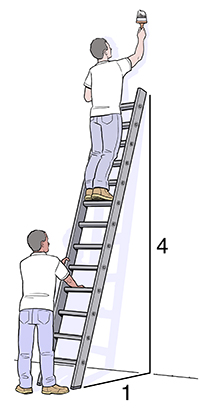A
B
C
D
E
F
G
H
I
J
K
L
M
N
O
P
Q
R
S
T
U
V
W
X
Y
Z
Click a letter to see a list of medical procedures beginning with that letter.
Click 'Back to Intro' to return to the beginning of this section.
Ladder Safety on the Job
Falls happen when you lose your balance. Standing on makeshift supports and using ladders incorrectly can cause you to fall. Using the wrong equipment for a task can also increase your chances of being hurt.
Watch for hazards
-
Makeshift supports. Makeshift supports are never quite right for the job. And they're not safe. For instance, don't stand on top of a trash can or chair instead of a stepstool or ladder. This raises your risk of falling and hurting yourself. Never make a short ladder taller by putting something under the legs. And be careful not to overreach. This can shift your center of gravity and make you lose your balance.
-
Incorrect use of ladders. Using equipment incorrectly is a common fall hazard. Ladders can pose major risks if used incorrectly. If you set a ladder too close or too far from a building, you're more likely to fall off of it. Other causes of falls include setting the ladder on loose, uneven ground. Or using a tall ladder by yourself without securing it. And never stand on the top of a stepladder. Also never use an extension ladder that's too short.
Use the right equipment and use it right
-
Find out what you need ahead of time.
-
Follow safety warnings on equipment.
-
Keep yourself centered over your support. This helps you keep your balance.
-
Keep your arms and legs as close to your center of gravity as possible (don't overreach).
-
Choose the right ladder for the job.
-
Do not use a metal stepladder near power lines or electrical equipment.
-
Do not tie 2 ladders together to make them longer.
-
Do not exceed the ladder’s maximum load rating.
Follow ladder safety rules
-
Inspect the ladder before using it. Look for any signs of damage. These include cracks, rust, or missing rungs.
-
Use the 1 to 4 rule. The base of the ladder needs to be placed 1 foot out from its support for every 4 feet of ladder length.
-
Set and secure the ladder on stable ground.
-
Have someone hold the base of the ladder. The base of the ladder should be secured.
-
Never use the top rung.
-
Wear correct footwear, such as nonslip flat shoes.
-
Make sure the ladder is fully extended before starting work.
-
Have 3 points of contact with the ladder at all times.
-
Do not carry any tools or materials in your hands when climbing a ladder. Carry them in a tool belt. Or raise tools up using a handline.
-
Stay near the middle of the ladder and face the ladder while climbing up or down.
-
Do not ignore nearby overhead power lines.
-
Position portable ladders (also called extension ladders) so that side rails extend at least 3 feet above the landing.
-
Keep ladders free of any slippery materials.
-
Prevent tipping the ladder over sideways or causing the ladder base to slide out.

Online Medical Reviewer:
Chris Southard RN
Online Medical Reviewer:
Marianne Fraser MSN RN
Online Medical Reviewer:
Vinita Wadhawan Researcher
Date Last Reviewed:
4/1/2024
© 2000-2024 The StayWell Company, LLC. All rights reserved. This information is not intended as a substitute for professional medical care. Always follow your healthcare professional's instructions.